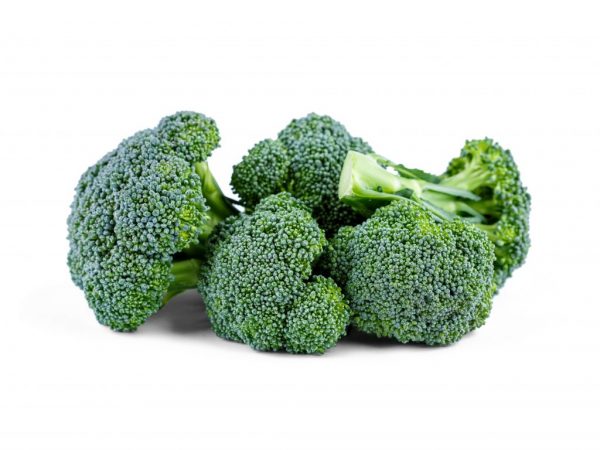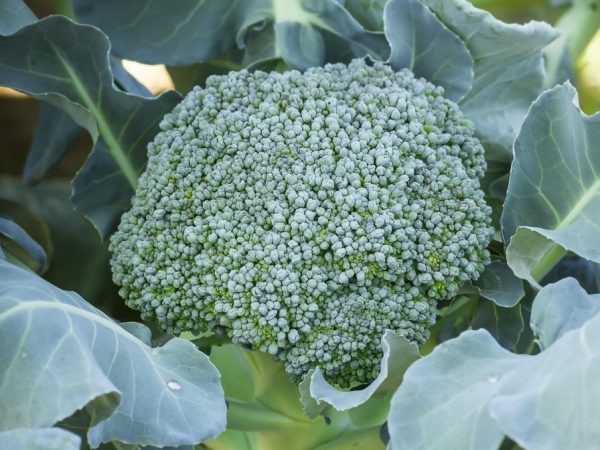Rules for growing broccoli in the Moscow region
Broccoli is the closest genetic precursor to cauliflower. Growing broccoli in the Moscow region is not difficult, even a novice gardener can handle it. The main thing is to choose the right variety.

Rules for growing broccoli in the Moscow region
Description of broccoli cabbage
Broccoli cabbage leaves are green, on the central and lateral shoots, several inflorescences are formed, which do not join together in a dense head. The flavor is similar to asparagus, which is why the variety is also called asparagus. Inflorescences and shoots are usually eaten.
The plant loves moisture and warmth, does not tolerate frost very well. Its main advantage is its short ripening period. After the first harvest, secondary inflorescences are formed on the remaining lateral shoots. Depending on the timing of ripening, there are:
- early;
- mid-season;
- late varieties.
Broccoli is grown in seedlings. The picking of sprouts into open ground is performed 35-40 days after sowing the seeds. Broccoli is often grown as a potted home plant.
Early maturing varieties
The best cabbage varieties for the Moscow region with an early ripening period are represented by the following varieties: Batavia F1, Linda, Lord F1, Tonus.
Early broccoli seeds are recommended to be sown in April. Caring for varieties of Peking cabbage for the Moscow region is no different from growing in other regions. The main thing is to constantly maintain soil moisture, otherwise the taste of vegetables will suffer.
The soil on the site begins to be prepared in the fall. Broccoli will yield a good harvest if grown in an area where legumes used to grow. These plants enrich the soil with oxygen, which is good for the development of asparagus heads.
Batavia F1
Medium early hybrid obtained by Dutch breeders. The ripening period is 8-90 days. Mature inflorescences are large. Their average weight is 800 g. Vegetable culture perfectly tolerates transportation, is stored for a long time.
The plant feels great outdoors. To maintain optimal moisture levels, the beds are mulched after each rain and watering. Top dressing is carried out 2 times per season. The first one - 20 days after sowing the seeds, the second - after another 2 weeks. Wood ash and organic matter are used as fertilizer.
The main thing is to harvest Batavia on time. During the period of technical maturity, the heads acquire a dark green color. If you miss the right moment, some of the nutrients will begin to disintegrate, and the taste of the vegetable will suffer.
Linda
Linda cauliflower is a first generation hybrid. Its ripening period is 75 days. The heads are dark green, their average weight is 400 g. After the first harvest, the inflorescences of the second order are formed on the remaining shoots. Sowing seeds is carried out from April 15 to May 1.
The plant feels great both in greenhouse conditions and in the open field.The variety is not susceptible to fungal diseases. Of the early ripe varieties of cabbage for the Moscow region, Linda is one of the most productive. This type of broccoli ranks first among its relatives in terms of iodine content.
Lord F1

Variety Lord is not afraid of temperature changes
It is a high-yielding variety. Its ripening period is 2 months. Sowing is carried out in mid-March-April. In open ground, seedlings dive at the end of April.
The stem of the plant has a dense structure, the heads are large, weighing up to 1.5 kg. Inflorescences of the second order continue to form until late autumn. Unlike other varieties, this one reacts normally to temperature changes.
Tone
This variety belongs to the most ancient. The heads of the inflorescences are not too large, only 200 g each. Cauliflower has a brownish tint. Seeds begin to sow in March, so that the plant has time to get stronger before diving into the open ground.
A transplant to the site is carried out in May. Immediately after the pick, the sprouts should be covered. The ripening period after picking seedlings is 30 days. Harvesting is carried out at the end of June. Fruiting with proper care lasts until early September.
Mid-season varieties
The best mid-season broccoli varieties for the Moscow region are presented in two varieties:
- Ironman F1.
- Dwarf.
It is recommended to plant varieties of medium ripening in a well-lit place. Watering is carried out every other day. The advantage is the ability to grow fruits at home.
These varieties take root well in cool climates, the optimum growing temperature is 16-18 ° C.
Ironman F1
High-yielding hybrid of the first generation. Its castings are blue-green in color. The central inflorescence is dense, weight is about 600 g. The bush ripens in 90 days. It is recommended to plant it with a seedless method in March. It feels great outdoors without additional cover.
In the hot season, the soil must be mulched after moistening, loosened in time. To avoid the spread of fungal diseases, a too tight fit is not recommended. The optimum distance between plants is 30 cm.
From 1 sq. m collect up to 3 kg of broccoli. The vegetable is distinguished by its high taste, it is perfectly stored. It can be used for freezing, fresh, for preparing various culinary delights.
Gnome

The variety has a compact inflorescence
The variety is distinguished by compact inflorescences. The weight of the central part is 300 g, with good care - 600 g. The shape of the head is elliptical. The plant has a powerful root, is not afraid of drafts.
Vegetable crops love open, well-lit areas. Does not tolerate shading. It is better to take the soil for planting seeds in the store.
Sowing is carried out in March. After 40 days, the seedlings dive into the area. Harvesting vegetables begins in the fall. Average yield indicators - 2.4 kg per 1 sq. m. The variety is excellent for fermentation, it is well kept fresh.
Late varieties
List of late varieties of cauliflower for the Moscow region: Agassi F1. Marathon F1.
Their ripening period is 130-150 days. Seeds begin to be sown in early March. It is better to plant seedlings from 15.04 to 15.05. Initially, crops need to be covered. In hot summers, the soil is mulched after each watering. To get a good harvest, fertilizers are applied in the form of organic matter 3 times per season.
Agassi F1
Heat-loving hybrid. The shape of the head is flat-rounded. The weight of the central inflorescence is 700 g. Productivity - 4 kg / sq. m.
The variety can grow in open ground and greenhouse conditions, responds well to loosening the soil and abundant watering. This variety can be grown at home on a windowsill and enjoyed fresh throughout the winter.
The crop is stored for up to 5 months, has a pleasant taste, and tolerates transportation well. Due to its high yield and quality characteristics, it is suitable for growing on an industrial scale.
Marathon F1
The hybrid is cold-resistant.The color of the head is blue-green, weight is about 800 g. The inflorescences have a soft texture, have a delicate taste. Productivity from 1 sq. m - 3 kg.
High quality lateral inflorescences. The hybrid grows well on slightly acidic soils with a pH level not higher than 6. If the indicator is too high, liming is carried out. The plant responds well to organic fertilizers.
Harvesting is carried out in September. This variety is very popular with gourmets, it is used in the preparation of various dishes and fresh, it is not suitable for conservation. It retains valuable minerals for 3-4 months.
Conclusion
Growing broccoli cabbage on a plot in the Moscow region is not at all difficult. Planting conditions are practically no different from those for white cabbage. The main nuance in care is keeping the soil moist, otherwise the vegetables will not be juicy enough and will not be able to form second-order inflorescences.
One of the benefits of broccoli is the ability to grow most varieties at home on a windowsill. In terms of useful qualities, broccoli is several times superior to white cabbage. It is often used in the diet and for preparing vegetable purees for children under one year old.


